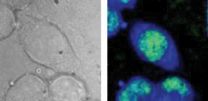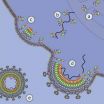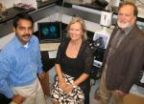(Press-News.org) A paper by researchers at the National Institute of Standards and Technology (NIST) may breathe new life into the use of a powerful—but tricky—diagnostic technique for cell biology. The paper,* appearing this week in the Biophysical Journal, demonstrates that with improved hardware and better signal processing, a powerful form of molecular vibration spectroscopy can quickly deliver detailed molecular maps of the contents of cells without damaging them. Earlier studies have suggested that to be useful, the technique would need power levels too high for cells.
The technique, "B-CARS,"** is one of several variations on Raman spectroscopy, which measures the frequencies associated with different modes of vibration of atoms and their bonds in a molecule. The exact mix of these frequencies is an extremely discriminating "fingerprint" for any particular molecule, so Raman spectroscopy has been used as a chemical microscope, able to detail the structure of complex objects by mapping the chemical composition at each point in a three-dimensional space.
In the biosciences, according to NIST chemist Marcus Cicerone, Raman spectroscopy has been used to detect microscopic cellular components such as mitochondria, detect how stem cells differentiate into new forms and distinguish between subtly different cell and tissue types. It can, for example, detect minor differences between various precancerous and cancerous cells, potentially providing valuable medical diagnostic information. Even better, it does this without the need to add fluorescent dyes or other chemical tags to identify specific proteins.
The catch, says Cicerone, is speed. The usual method, spontaneous Raman scattering takes a long time to gather enough data to generate a single spectrum—as much as seven minutes for fine detail—and that's for each point in the image. "Seven minutes or even five seconds per spectrum is not feasible when we need a million spectra for an image," he observes. CARS, which uses a pair of lasers to pump up the vibrational states and increase signal, is part of the answer. The current breakthroughs for a broadband CARS instrument developed at NIST since 2004, says Cicerone, gets the same information in 50 milliseconds per pixel.
The new catch is power. Recent papers have argued that to get the necessary data, the lasers used in CARS must run at power levels above the damage threshold for living cells, making the technique nearly useless for clinical purposes. Not quite, according to the NIST team. Their paper describes a combination of improved hardware to gather spectra over a very broad range of wavelengths, and a clever mathematical technique that effectively amplifies the useable signal by examining a portion of signal normally ignored as background interference. The result, says Cicerone, pushes their minimum power level below the damage threshold while retaining the speed of CARS. "We have all the information that you have in a Raman spectrum but we get it 5 to 100 times faster," he says, adding that some obvious modifications should push that higher, opening the door to more widespread use of vibrational spectroscopy in both biology and clinical diagnosis.
INFORMATION:
* S.H. Parekh, Y.J. Lee, K.A. Aamer and M.T. Cicerone. Label-free cellular imaging by broadband coherent anti-Stokes Raman scattering microscopy. Biophysical Journal. V. 99, Oct. 13, 2010.
** For "broadband coherent anti-Stokes Raman scattering"
Faster CARS, less damage: NIST chemical microscopy shows potential for cell diagnostics
2010-10-15
ELSE PRESS RELEASES FROM THIS DATE:
New look at multitalented protein sheds light on mysteries of HIV
2010-10-15
New insights into the human immunodeficiency virus (HIV) infection process, which leads to acquired immunodeficiency syndrome (AIDS), may now be possible through a research method recently developed in part at the National Institute of Standards and Technology (NIST), where scientists have glimpsed an important protein molecule's behavior with unprecedented clarity.
The HIV protein, known as Gag, plays several critical roles in the assembly of the human immunodeficiency virus in a host cell, but persistent difficulties with imaging Gag in a lab setting have stymied researchers' ...
New small business law could have big effect on retirement accounts
2010-10-15
CHAMPAIGN, Ill. – A new law aimed at helping stimulate small business job growth through tax deductions could have major consequences for anyone with a retirement savings account at work, a University of Illinois expert on taxation and elder law notes.
Law professor Richard L. Kaplan says an obscure provision in the recently enacted Small Business Jobs Act allows 401(k), 403(b) or 457 account holders to convert their retirement savings into a tax-advantaged Roth-version of the same account.
The good news, according to Kaplan, is that by converting to a Roth variant, ...
This little light of mine: Changing the color of single photons emitted by quantum dots
2010-10-15
Researchers at the National Institute of Standards and Technology (NIST) have demonstrated* for the first time the conversion of near-infrared 1,300 nm wavelength single photons emitted from a true quantum source, a semiconductor quantum dot, to a near-visible wavelength of 710 nm. The ability to change the color of single photons may aid in the development of hybrid quantum systems for applications in quantum communication, computation and metrology.
Two important resources for quantum information processing are the transmission of data encoded in the quantum state of ...
Charcoal biofilter cleans up fertilizer waste gases
2010-10-15
Removing the toxic and odorous emissions of ammonia from the industrial production of fertilizer is a costly and energy-intensive process. Now, researchers in Bangladesh have turned to microbes and inexpensive wood charcoal to create a biofilter that can extract the noxious gas from vented gases and so reduce pollution levels from factories in the developing world.
Writing in the International Journal of Environment and Pollution, Jahir Bin Alam, A. Hasan and A.H. Pathan of the Department of Civil and Environmental Engineering, at Shahjalal University of Science and Technology, ...
Mayo Clinic finds early success with laser that destroys tumors with heat
2010-10-15
JACKSONVILLE, Fla. — Physicians at Mayo Clinic's Florida campus are among the first in the nation to use a technique known as MRI-guided laser ablation to heat up and destroy kidney and liver tumors. So far, five patients have been successfully treated — meaning no visible tumors remained after the procedure.
They join their colleagues at Mayo Clinic's site in Rochester, Minn., who were the first to use laser ablation on patients with recurrent prostate tumors.
Although the treatment techniques are in the development stage, the physicians say the treatment is potentially ...
Perspectives on improving patient care: Genetics, personalized medicine, and behavioral intervention
2010-10-15
Personalized medicine — improving the fit between patient and treatment — has become a major focus of research in fields from cancer treatment to the psychopharmacology of mental disorders. Genetic studies have suggested that an individual's genetic makeup renders him either more or less sensitive to stressful social environments — but can an individual's unique genotype also determine the effectiveness of preventative or therapeutic behavioral interventions?
The current issue of Perspectives on Psychological Science, a journal of the Association for Psychological Science, ...
Study: Waist circumference, not BMI, is best predictor of future cardiovascular risk in children
2010-10-15
Athens, Ga. – A new long-term study published by researchers at the University of Georgia, the Menzies Research Institute in Hobart, Australia and the Murdoch Childrens Research Institute in Melbourne, Australia suggests that waist circumference, rather than the commonly used body mass index measure, is the best clinical measure to predict a child's risk for cardiovascular disease and diabetes later in life.
The researchers, whose results appear in the early online edition of the International Journal of Obesity, found that children with high waist circumference values ...
UT Dallas researcher helps reveal more complete picture of Martian atmosphere
2010-10-15
Instruments designed by a UT Dallas professor to measure atmospheric components on the surface of Mars have uncovered important clues about the planet's atmosphere and climate history.
The findings, published in a recent issue of the journal Science, reveal how carbon dioxide isotopes have reacted to volcanic activity, water and weathering – thus forming a more complete picture of the current Martian atmosphere.
The NASA mission in which this work was accomplished was the Phoenix Lander, an unmanned spacecraft deployed to Mars in 2008.
UT Dallas Physics Professor ...
Anti-vomiting drug could prevent thousands of hospitalizations, save millions of dollars
2010-10-15
CHAPEL HILL – Two years ago, a study by University of North Carolina at Chapel Hill researchers found that an anti-vomiting drug called ondansetron helps reduce vomiting, the need for intravenous fluids and hospital admissions in children with acute gastroenteritis.
Now a new economic analysis led by Canadian researchers, in collaboration with Michael J. Steiner, MD, assistant professor of pediatrics at UNC, concludes that routinely giving ondansetron to children with gastroenteritis-induced vomiting would prevent thousands of hospitalizations and save millions of dollars ...
UCSB scientists discover inner workings of potent cancer drug
2010-10-15
(Santa Barbara, Calif.) –– A potent drug derived from an evergreen tree may soon save the lives of some patients with the deadliest form of breast cancer. According to the National Cancer Institute, breast cancer will claim approximately 40,000 lives in the U.S. this year.
Scientists at UC Santa Barbara, in cooperation with scientists in the pharmaceutical industry, have discovered the mechanism by which this drug kills cancer cells. The team has isolated the drug's action in the test tube as well as in cancer cells.
The results are reported in two studies published ...




